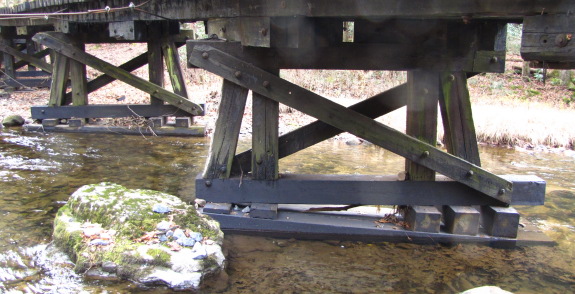
Footbridge observations

I saw this massive footbridge
today while we were out hiking and it made me stop and think of how
they used railroad ties to anchor it in the water.
I'm pretty sure our
little footbridge was too
long and a little support like this in the middle might have been
enough to save it from a premature death.
Want more in-depth information? Browse through our books.
Or explore more posts by date or by subject.
About us: Anna Hess and Mark Hamilton spent over a decade living self-sufficiently in the mountains of Virginia before moving north to start over from scratch in the foothills of Ohio. They've experimented with permaculture, no-till gardening, trailersteading, home-based microbusinesses and much more, writing about their adventures in both blogs and books.
Want to be notified when new comments are posted on this page? Click on the RSS button after you add a comment to subscribe to the comment feed, or simply check the box beside "email replies to me" while writing your comment.

This is essentially a floating foundation. It's a neat and simple idea. I especially like the idea of using blocks and wedges to get the top tie horizontal, and giving the bridge room to expand and contract.
However this foundation is not anchored; If a big enough piece of debris were to float down the stream, it could knock the foundation from under the bridge. The vertical posts look untreated, so they'll start to rot at the sawn ends after a while. All in all, I wonder how long it will last?
OTOH, it is quite simple to make and to repair. A lot easier that digging a real foundation in a streambed!
What would concern me is the water flow. A fast flow would erode the riverbed that the tie is sitting on, making it sink deeper and deeper.
I was also wondering how often they need to replace those parts.
If you look at the picture closer you will notice a steel cable which I think is working to hold back the bridge from budging if a large piece of debris rams into it.
Judging by the gray color, It looks like the parts that are mostly submerged (the ties and the blocks between them) have been coated with something before they were laid down into the riverbed to prevent rotting. That would make sense, I think.
Recently I read an article about a self-built wooden bridge that lasted 16 years before it needed major repairs.
I think you are right about the cables. It could even be that the flow at high water is strong enough to shift the bridge, hence the cables. That is one of the tricky points of a floating foundation for a bridge, I guess. Even the ancient Romans already employed hand-powered pile drivers to hammer in decent bridgeposts.
The wood is actually huge railroad ties, impregnated with whatever rot-resistant stuff they use for those. They used the same wood all the way up, although you can't really tell from the photo, since they were replacing an old railroad trestle and wanted to keep the same look going, presumably.
I like the page you linked to --- that's my kind of on-the-cheap bridge.
Wooden ties were usually treated with coal tar creosote, which acts as a biocide.
Not something I'd want in a creek where I'd get my drinking water from. 4-6 mg/l is enough to kill fish (LC50).